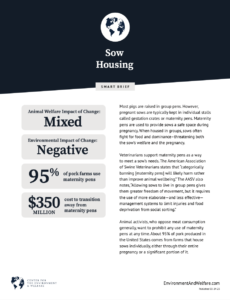
Background
Most pigs are raised in group pens. However, pregnant sows are typically kept in individual stalls called individual maternity pens or gestation stalls in order to protect them from each other and facilitate individually tailored feeding and care. According to court filings, about 95% of pork produced in the United States comes from farms that house sows in individual maternity pens. However, animal rights activists claim this practice is cruel and are demanding companies pledge to only buy “crate-free” pork.
What Experts Say
Veterinarians acknowledge individual sow housing is one way to meet a sow’s needs. The American Association of Swine Veterinarians lists several criteria for sow welfare, including protection from the elements, “minimiz[ing] aggression and competition between sows,” and “facilitat[ing] evaluation and care of individual animals while protecting worker safety” –which are all provided by individual sow housing.
The American Veterinary Medical Association states, “There are advantages and disadvantages to any sow housing system and the benefits and harms to the animals of each should be considered by weighing scientific evidence and veterinary professional judgment. For example, while [individual maternity pens] minimize aggression and injury, reduce competition, and allow individual feeding and nutritional management, they restrict normal behavioral expression. Group housing systems are less restrictive, but could lead to increased lameness and undesirable social behaviors, such as aggression and competition for resources (e.g., feed, water, space to lie down).”
Animal Welfare Impact of Changing to Group Housing
Mixed. While sows will have more space to move, they are also at risk of suffering violent clashes over food or to establish social hierarchy, and competition for food results in under- and over-feeding of animals.
Environmental Impact of Changing to Group Housing
Negative. Group sow housing often results in higher rates of injury, abortion, and miscarriage in sows. This can result in less efficient production per sow, requiring more pigs to be raised to meet consumer demand, which in turn requires more feed and water to raise the additional hogs, land on which to grow the feed, and fuel (for transport).
Alternative Systems
Some pork producers have changed their practices to house sows individually until pregnancy can be confirmed. This is to ensure proper embryo implantation in the sow and may take several weeks. However, animal activists have attacked companies that use this reduced-maternity pen system. (See Case Study: McDonald’s)
Other pork producers have created a “hybrid” model of individual stalls with a common area and have found that sows choose to spend most of their time in the individual maternity pens.

